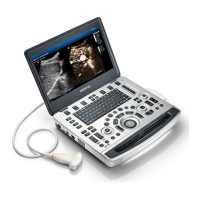8 - 6 Operator’s Manual
8 Elastography
Press <Measure> to enter application measurement. You can perform measurements on Isthmus
and Mass, etc.
For details, see "Advanced Volume".
8.2.4 Cine Review
Press <Freeze> to freeze the image and enter cine review state.
Or, click the cine to enter the cine review state.
8.3 STQ Imaging (Sound Touch Quantification)
STQ imaging is not supported when the system is powered by battery.
8.3.1 Basic Procedures for the STQ Imaging
1. Select a proper probe. Perform 2D scan to locate the lesion.
2. Tap [STQ] on the touch screen. Or press the user-defined <STQ> key to enter the STQ mode.
3. Adjust the ROI based on the lesion size and the position.
4. Press <Update> to generate the acquisition. Place the probe still with stable force (not
pressing, sweeping or moving the probe) to acquire the image. Adjust the B image parameters
to obtain a premium image.
The stress curve shows at the bottom of the screen after entering the real-time acquisition.
The following indices display besides end of the curve in real-time:
– Elasto modulus inside the ROI of the current frame;
– The mean value, maximum value, minimum value, SD value of shear velocity;
– Depth value of the active elasto modulus.
5. Freeze the image, and replay the image if necessary.
6. Save the single-frame and multi-frame image.
7. Reacquire the image if necessary.
8. Press <B> on the control panel or tap [STQ] on the touch screen to exit the elastography
imaging mode, and return to B mode.
8.3.2 Image Parameters
ROI Adjustment
Used to adjust the ROI position and scale in STQ imaging.
The cross “+” shows the center of the ROI, and the depth appears at the right bottom of the screen.
Elas. Metric
Display the changes of elasto metric’s average value inside the ROI by elasto curve. It is convenient
to the doctor to choose the stable measurement result.
The square height of the elasto curve (Y-axis represents elasto metric; X-axis represents the time)
represents the average value of the elasto metric for current frame.
The metric includes Young’s modulus E (unit: kPa), and shear modulus G (unit: kPa).

